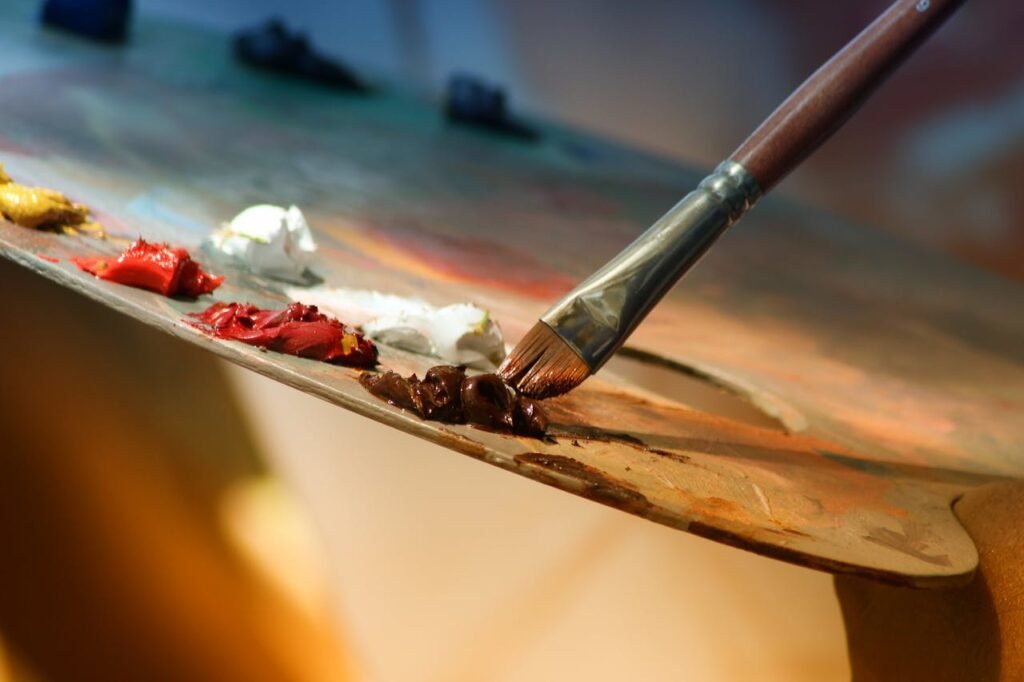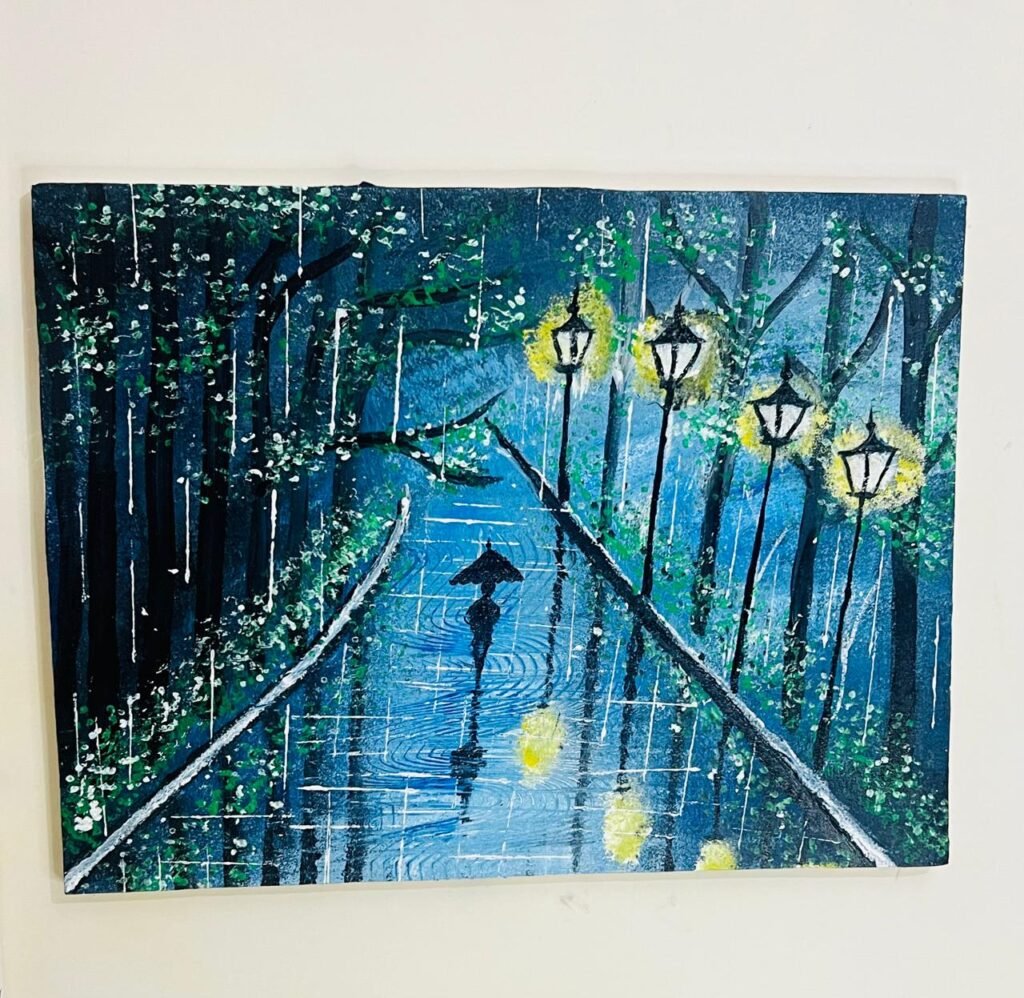Table of Contents
Introduction
“Rainy Night Painting” have always held a mysterious and enchanting allure, evoking feelings of peace, solitude, and introspection. As an artist, capturing the essence of a rainy night through painting can be a deeply rewarding experience. In this article, we’ll explore the inspiration and techniques behind creating a “Rainy Night Painting,” specifically focusing on a serene stroll through a lamp-lit forest path. This piece not only highlights the beauty of rain and its reflections in water but also brings to life the quiet elegance of street lamps illuminating a nighttime forest.
Inspiration Behind the Painting
The idea for this painting stemmed from a desire to capture the tranquility of a quiet night walk under the rain. The scene is simple yet profound—a lone figure with an umbrella, walking down a forest path. The street lamps softly light the way, their reflections dancing on the wet pavement. The surrounding trees, with their dark silhouettes, add depth and contrast, making the bright lights and rain-soaked path stand out even more. This painting aims to evoke a sense of calm, allowing viewers to immerse themselves in the serenity of the moment.
Composition and Layout
The composition of the painting is designed to draw the viewer’s eye along the path, leading them from the foreground to the background. The central element is the lone figure under the umbrella, positioned slightly off-center to create a dynamic balance. The path, lined with street lamps, guides the viewer’s gaze deeper into the forest, enhancing the sense of depth and perspective.
The trees, painted in dark tones, frame the scene, creating a natural border that keeps the viewer’s focus on the path and the figure. The reflections in the water add a layer of complexity to the painting, mirroring the lights and creating an almost dreamlike quality.
Techniques for Painting Rain and Reflections

Painting rain and reflections requires a delicate touch and attention to detail. The rain in this painting is depicted with fine, vertical lines, using a thin brush to create the effect of falling water. The reflections are achieved by blending the colors of the lights and the path, adding ripples to mimic the movement of water.
- Rain Effects: To create a realistic rain effect, start by mixing a slightly lighter shade of the background color. Using a fine brush, paint thin, straight lines across the canvas, varying the length and spacing to create a natural look. You can also add small splashes on the ground to indicate where the raindrops are hitting.
- Reflections in Water: Reflections are a crucial part of this painting, adding depth and realism. Start by painting the primary objects—such as the street lamps—in full detail. Once dry, use a softer brush to create the mirrored image on the water’s surface, blending the edges to give it a fluid appearance. Adding subtle ripples with a thin brush will enhance the effect, making the water appear more dynamic.
The Role of Lighting in Nighttime Paintings
Lighting plays a crucial role in setting the mood of any nighttime painting. Rainy Night Painting In this piece, the street lamps are the primary light source, casting a warm, yellow glow that contrasts beautifully with the cool blue tones of the night. The way the light interacts with the rain and the wet pavement is central to the painting’s composition.
- Street Lamps as Focal Points: The street lamps are positioned strategically along the path, each one slightly smaller and less detailed as they recede into the background. This creates a sense of depth and guides the viewer’s eye along the path. The warm glow of the lamps contrasts with the cool tones of the surrounding forest, adding visual interest and enhancing the mood.
- Highlighting the Path: The path itself is highlighted by the reflections of the lamps, creating a luminous trail that draws the viewer’s eye. This interplay of light and shadow is crucial for creating the serene, almost magical atmosphere of the painting.
- Capturing the Glow: To capture the soft glow of the street lamps, start with a bright yellow or warm white base. Gradually blend in darker tones around the edges, softening the light as it diffuses into the surrounding air. The glow should be subtle, giving the impression of light gently illuminating the foggy, rainy night.
Adding Depth and Atmosphere
Creating a sense of depth in a nighttime painting involves careful attention to the foreground, midground, and background elements. “Rainy Night Painting” In this painting, the depth is achieved through the careful placement of trees, the path, and the figure.
- Foreground Elements: The trees in the foreground are painted with more detail and darker tones, bringing them closer to the viewer. The raindrops and splashes on the ground add a layer of realism, anchoring the viewer in the scene.
- Midground and Background: The midground features the street lamps and the path, leading the viewer’s eye deeper into the painting. The background is kept slightly blurred, with softer edges and lighter tones to suggest distance. This layering effect helps to create a three-dimensional space on a two-dimensional canvas.
- Atmospheric Perspective: Atmospheric perspective is used to enhance the depth, with the colors becoming cooler and lighter as they recede into the background. The misty rain further blurs the distant elements, adding to the overall mood and atmosphere.
Emphasizing the Solitude and Tranquility
One of the key themes of Rainy night painting is the solitude and tranquility of a rainy night. The lone figure walking down the path adds a sense of peaceful introspection, inviting the viewer to step into the scene and experience the quiet beauty of the moment.
- The Solitary Figure: The figure with the umbrella is deliberately understated, almost a silhouette. This allows viewers to project themselves into the scene, making the experience more personal. The figure’s posture and placement convey a sense of calm and purpose, as if they are enjoying the solitude of the night.
- The Quiet Path: The empty path, illuminated by the soft glow of the lamps, enhances the feeling of solitude. There is a sense of timelessness in the scene, as if the viewer has stepped into a moment that exists outside of the hustle and bustle of daily life.
- The Sound of Rain: Though the painting is silent, the imagery evokes the soft, steady sound of rain falling on leaves and pavement. This auditory element adds to the tranquility, making the viewer feel as though they are actually there, walking down the quiet path on a rainy night.
Reflection on the Creative Process
Creating a “Rainy Night Painting” like this one is both a technical challenge and a deeply personal artistic journey. The interplay of light and shadow, the subtle reflections, and the mood of the scene all require careful thought and execution.
- Experimentation with Techniques: Throughout the process, experimentation with different brush techniques, color blending, and layering was key to achieving the desired effects. For example, the reflections in the water were refined over several layers, gradually building up the depth and realism.
- Balancing Detail and Simplicity: Striking the right balance between detailed elements, like the street lamps and reflections, and simpler forms, like the trees and background, was essential. This balance helps to keep the focus on the main elements of the painting while still providing a rich, immersive experience.
- Emotional Connection: Ultimately, this painting is about more than just capturing a scene—it’s about conveying a feeling. The quiet beauty of a rainy night, the solitude of a lone walk, and the soft glow of street lamps are all meant to evoke a sense of peace and introspection in the viewer.
Conclusion
“Rainy Night Painting: A Serene Stroll Through a Lamp-Lit Forest Path” is more than just a depiction of a rainy evening—it’s an invitation to step into a world of tranquility and reflection. The careful composition, use of light and shadow, and attention to detail all work together to create a painting that is both visually stunning and emotionally resonant.
Whether you’re an artist looking to explore the theme of rainy nights or an art lover who appreciates the beauty of nature, this painting offers a glimpse into the serene, almost magical world that rain can create. Through the use of reflections, street lamps, and the quiet presence of a lone figure, this piece captures the essence of a rainy night in a way that is both timeless and deeply personal.
Rainy night painting not only showcases the technical skill required to depict a complex scene but also highlights the emotional depth that can be achieved through art. As you continue your journey in painting, consider exploring similar themes and techniques to create your own unique interpretations of the serene beauty found in nature.
